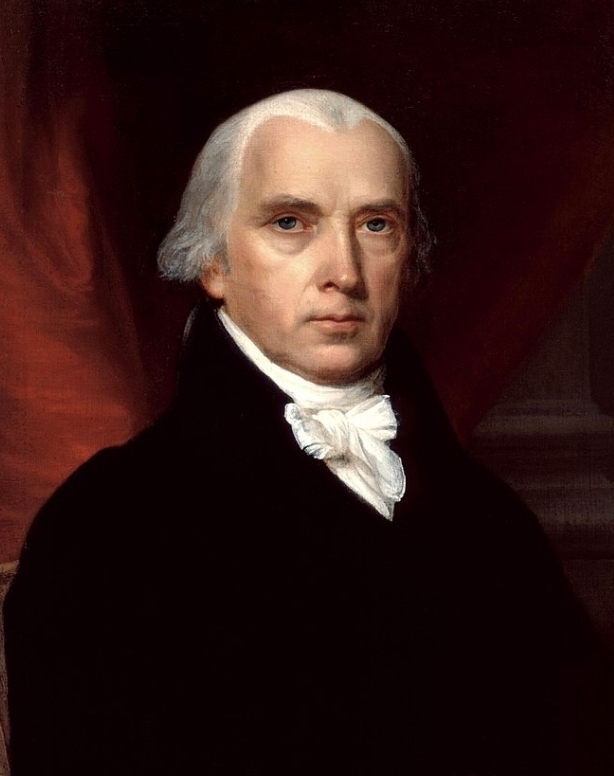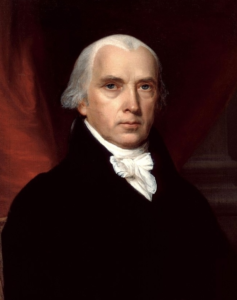James Madison: America’s Constitutional Freedom Fighter

James Madison is remembered as the “Father of the Constitution,” and for good reason. His unique approach to politics balanced majority rule and minority rights through a series of battles that forged our constitutional system. His fight for religious liberty in Virginia, the ratification of the Constitution, the founding of the Republican Party, and the Nullification Crisis are just a handful of battles that were integral to the American founding and the legacy of our constitutional republic. At the center of each stood the great little Madison.
At 5 foot 4 inches, Madison proved it’s not the size of the Founder in the fight but the size of the fight in the Founder that counts.
James “little Jemmy” (to friends) Madison was born in March 1751 into a large and growing Virginia family. Much like his Virginia neighbor and later best friend and mentor Thomas Jefferson, books were an early and constant companion to the young Madison. He studied close to home in Virginia and then at the College of New Jersey—Princeton—under the tutelage of the renowned Scotsman, Rev. John Witherspoon. After his studies were complete, he returned to Virginia and began a life lived in battles for liberty and constitutionalism.
The first of those battles was for religious freedom and disestablishment of religion in Virginia.
Religious freedom in Virginia
Upon Madison’s return from college to Virginia, he found his state jailing Baptists for their faith. “This vexe[d] [him] the most of any thing whatever.” His fellow freedom-fighter Jefferson had some years earlier drafted the Virginia Statute of Religious Freedom, which prohibited any coercion in religious worship and protected the expression of religious opinion. But Virginia never ratified it into law.
In 1776, while at work on the Virginia Declaration of Rights, Madison was able to convince George Mason to change the text of the Declaration’s protections for religious freedom from mere toleration to free exercise of religion. But much work remained to be done.
In 1784, the opportunity to advance religious freedom emerged. Madison faced Patrick Henry and leading Virginia elites pushing for a tax to be levied on all Virginians to support Protestant ministers. Madison acted. He penned a Memorial and Remonstrance Against Religious Assessments. He made both rational and theological arguments for religious freedom. He argued that it is impossible for an individual to “follow the dictates of other men” with respect to matters that depend “only on the evidence contemplated by their own minds.” He then made the theological argument that the individual has a duty to “render to the Creator such homage, and such only” as the individual believes to be acceptable to God.
Madison’s efforts defeated the tax and turned the tables, ultimately resulting in the legislature passing Jefferson’s bill.
Through this experience, Madison learned that the key to facilitating freedom and intellectual diversity among contending factions was disestablishing central control.
This was a principle he would employ throughout his political life. He carried it into the Constitutional Convention, and it animated his most famous contribution to the science of “politicks”—Federalist 10.
Pluralism, contending factions, and intellectual diversity
In Federalist 10, Madison explained that an extended republic would best prevent a faction or factions from acting on some “common impulse of passion, or of interest, adversed to the rights of other citizens, or to the permanent and aggregate interests of the community.” Madison was able to take his stance on religious pluralism in Virginia and apply it to the burgeoning commercial republic. What was true of religious diversity could also be true of political and economic diversity.
An extended republic would, Madison argued, prevent infringements on “the public good and private rights” with respect to all rights and legislation.
Pluralism became a staple of Madison’s thinking about constitutionalism throughout his career. He believed that pluralism could create harmony through conflict if the government played the role of umpire, rather than exercising central control. Pluralism, contending factions, and intellectual diversity emerged from Madison’s mind as the solution to balancing majority rule with the rights of minorities.
Madison also noted in Federalist 10 that “the most common and durable source of factions has been the various and unequal distribution of property.” This quote highlights another minority group—property owners—who, like religious dissenters, motivated Madison’s constitutional activities in the 1780s. He opposed the “excesses of democracy” that had been happening in many states, specifically paper-money schemes that inflated the value of money and devalued land. This amounted to nothing less than a taking of property in Madison’s eyes.
In his Vices of the Political System of the United States, he objected to trade barriers between states. These barriers interfered with commerce and property owners’ ability to do business and generate wealth in the Republic. It was this stance that eventually resulted in constitutional provisions like the grant of power to regulate commerce to the federal government, the prohibition on state infringements of contract, and the ban on states laying imposts or duties on imports or exports between states.
Again, Madison wanted to protect the rights of the minority, in this case property owners. He saw the barriers imposed by the various states as majoritarian excesses trampling minority rights. His solution: create a federal government that would act as a neutral arbiter between contending private forces. Unlike his fellow federalist, Alexander Hamilton, Madison did not believe we should simply trade centralized state power for centralized federal power.
Madison traded the power of government for the power of ideas. Disestablishment generated diversity of opinion. Extending the republic brought in a multiplicity of diverse opinions to prevent majority factions from forming, over-legislating, and tyrannizing minorities. As Justice Antonin Scalia famously admonished, “learn to love the gridlock” because the Framers—Madison chief among them—designed our system with “power contradicting power (to prevent) an excess of legislation.”
And Madison parlayed these ideas into his arguments for designing and ratifying the Constitution. He viewed the structure of the Constitution—its separation of powers, checks and balances, and limited-and-enumerated powers design—as essential for channeling the political contests and factionalism created by the extended republic into the best legislative action. This Madisonian design vindicates the common good while protecting the rights of minorities.
Political struggles and new political parties
Of course, Madison also lost battles. But he doggedly pivoted those losses into opportunities for greater victories. For example, Madison’s three pet ideas at the convention—(1) a congressional negative over state laws, (2) popular representation in both houses of Congress, and (3) a council of revision in the executive to review federal laws—all failed. Yet, he still threw his intellectual vigor into the fight for ratifying that very Constitution.
Madison lost the first major battle under the new Constitution against Alexander Hamilton’s financial system and the Bank of the United States. But he would turn that opposition into success against the Federalist in the late 1790s. His opposition to the Bank also paralleled his fight against an establishment of religion in Virginia. He was against centralized control of religion, and he was against centralized control of the economy. He strongly favored the twin pillars of the classical liberal order—free exercise and free enterprise. Again, his loss to Hamilton was a springboard to a future success. It energized him to create an opposition party—the Republicans—perhaps the most successful political party in American history.
The rise of Madison’s Republican Party came on the defeat of his first political party, the Federalists. He began to develop the Republican Party through personal networking, a series of newspaper essays, and then polemical debates against Hamilton.
In the central contest of this political struggle—the Republican opposition to the Alien and Sedition Acts—Madison again combined a fight for freedom and structural constitutionalism. Echoing his arguments against the Bank, Madison argued these acts went beyond the scope of federal power. But he also asserted the Sedition Act violated the First Amendment’s protections for free speech and press.
His Report of 1800 best exemplifies his constitutional strategy. In it, he argued the Sedition Act was unconstitutional because “no power whatever over the press, was supposed to be delegated by the constitution, as it originally stood; and that the amendment was intended as a positive and absolute reservation of it.” In the Election of 1800, Madison realized the triumph of his second movement and party—the first was the Federalist Party for constitutionalism, governmental vigor, and the rule of law—and the second for freedom, limited government, and republicanism. As always, he, and perhaps he alone, saw each as two sides of the same coin, and played the flip to America’s advantage. This dynamic of balancing federalism and republicanism, each suffuse with liberalism, was a hallmark of Madison’s adroit political career and exemplified his timeless constitutional creativity and political genius.
Last breath and a lasting legacy
Although his presidency is often viewed as a failure, he managed an underappreciated success—he steered America to victory against the world’s greatest superpower and refused to suspend civil liberties during that war. Once again, he balanced a government with the necessary vigor to survive with the protection of inalienable natural rights.
The Capitol burned. An unmitigated catastrophe. And yet, the fledgling republic again defeated the world superpower. That victory ultimately rested on an important truth: America’s strength is not in her high halls of government, but instead in her rural hills, towns, and cities, in an affectionate attachment to her ideals, woven into the hearts and minds of her people, and in her commitment to the triumph of human freedom, equality, and happiness.
Finally, Madison retired. His retirement, however, did not cease his intellectual engagements. He worked to finish his notes on the federal convention, begun in 1787. He knew his work on behalf of the Constitution would be his most important, and he carefully curated his notes for publication. He would save publication until the last delegate had passed. Fittingly, he lived the longest of any member of the Grand Convention. At the same time, he fought his final battle to preserve his life’s work—the American Union. In the face of President Andrew Jackson and John C. Calhoun’s struggle for sectional division and state nullification, Madison spoke up for preserving the Union. And ultimately the nullification crisis was squelched.
In his final advice to his country, he wrote, “The advice nearest to my heart and deepest in my convictions is that the Union of the States be cherished & perpetuated. Let the open enemy to it be regarded as a Pandora with her box opened; and the disguised one, as the Serpent creeping with his deadly wiles into Paradise.” In exhorting his fellow Americans, the sons and daughters of the Constitution, to cherish the Republic created on the foundations of western civilization’s two great cities, Madison weaves in illustrative references to both Athens and Jerusalem, infusing powerful imagery into his advice to the people and ideas he had served for more than 80 years.
On June 28, 1836, Madison passed the torch. At breakfast with his niece, he discovered he could not swallow. His niece realized something was wrong in her uncle’s face. She asked him what was wrong. He remarked “Nothing more than a change of mind, my dear.” And the great mind behind the Constitution—the Madison Head—instantly dropped, quietly as the snuff of a candle goes out, active until the last.
John Adams’ famous last words were “Jefferson lives.” One might say the same thing today about his younger Virginia compatriot—“Madison lives.” Even after his biological death, the mind of Madison is still active. He lives on in his many contributions and creations. His unique brand of politics—partisan and pluralist—still defines the bedrock of American politics.
The Constitution endures and Madison’s views on its meaning carry as much weight as those of anyone who ever interpreted the document. His ideas on religious liberty persist. His views on the separation of powers are our mainline view. His writings in the Federalist remain seminal contributions in the history of political thought. He created the first two contending political parties. That political contest continues today. Indeed, in an ironic twist of history, the modern Democratic Party traces its lineage to Jefferson and Madison. His position on the Alien and Sedition Acts forms the core of modern First Amendment doctrine. And his position during the Nullification Crisis on behalf of the Union triumphed in the Civil War and defines the nature of our nation today. In innumerable ways, Madison lives. And his mind’s creative constitutional genius will remain active as long as America lives.



